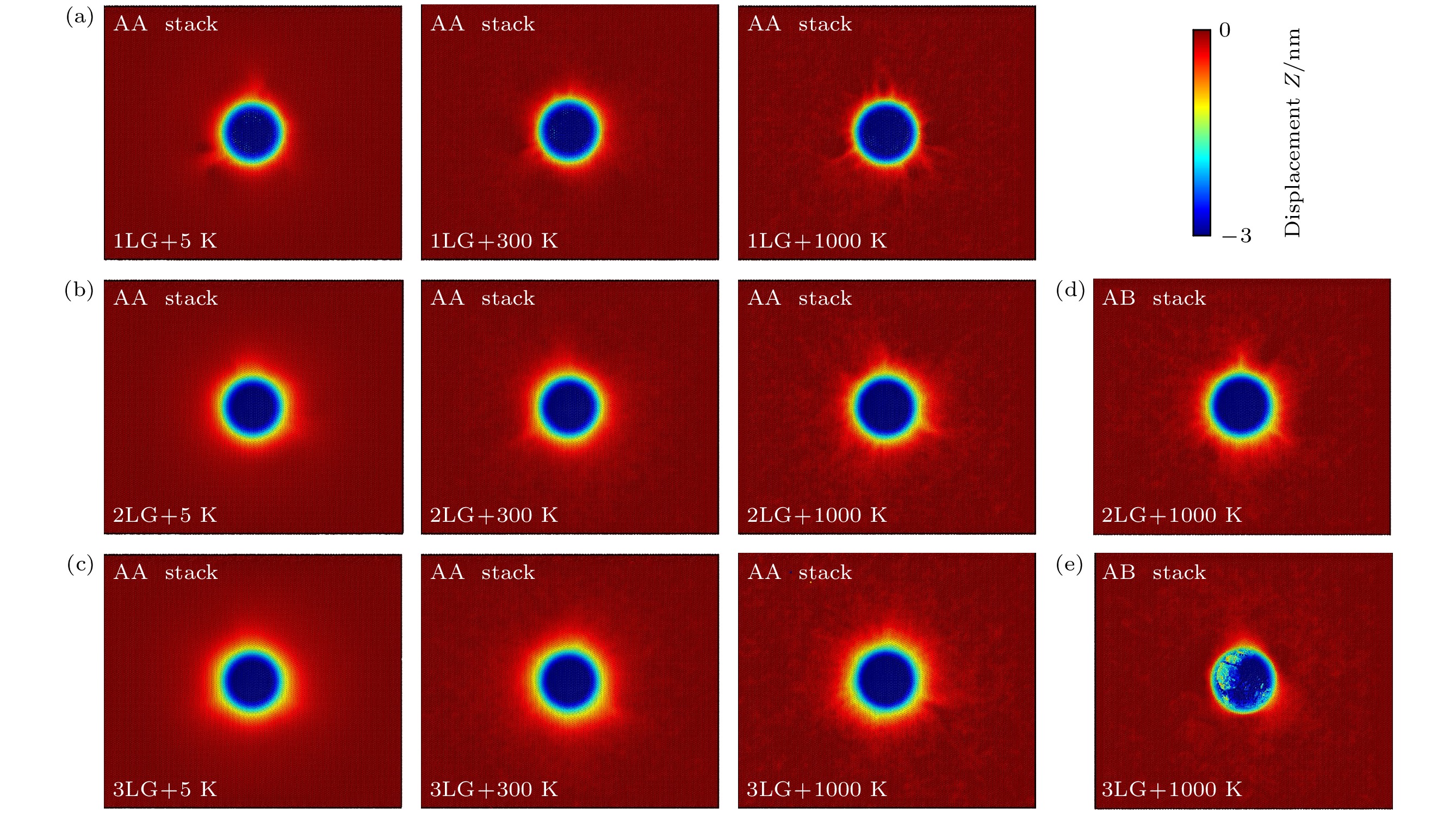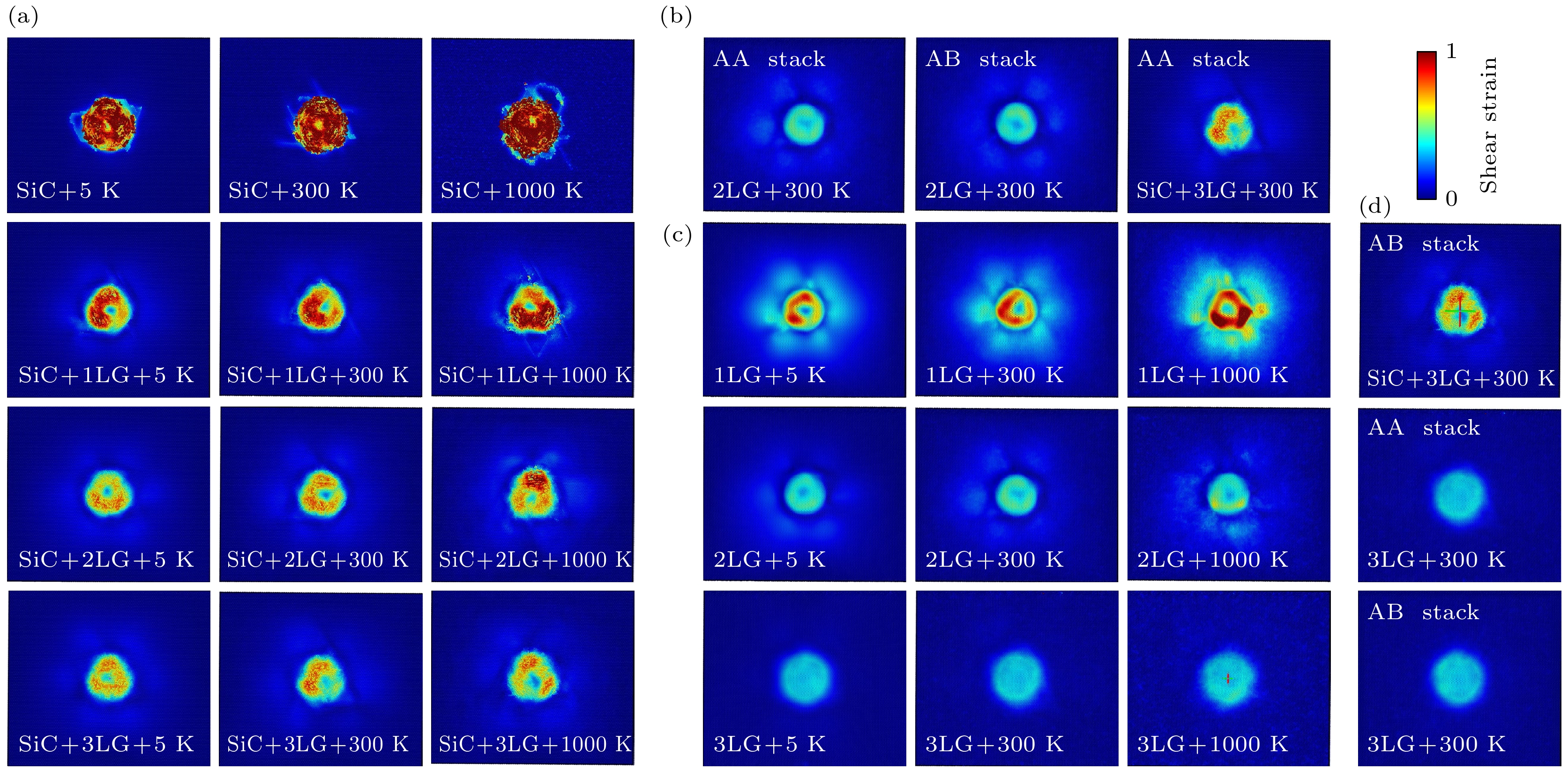-
微机电系统半导体SiC器件覆多层石墨烯的力学强化性能与塑性变形微观研究, 将对提升该器件耐久性服役寿命期和强韧化机制理解起到显著作用. 因此, 本文基于分子动力学法探讨了石墨烯堆垛类型(AA和AB堆垛)和极端使役温度对其接触力学性能(最大承载荷、硬度、杨氏模量、接触刚度)、微结构演化、接触质量、褶皱形貌、位错总长的影响, 解释了SiC基底覆多层石墨烯力学强化的原子尺度机制. 研究发现: 相同使役温度下, 随覆石墨烯层数增加, SiC基底微结构的棱柱形位错环演化中越早发生脆断; 石墨烯AB堆垛在最大压深时的C—C键断裂会导致石墨烯优异面内弹性变形丧失, 以致其最大承载性呈现断崖式下降. 研究表明: SiC基底覆三层石墨烯的力学强化性能是纯SiC的2倍, 该强化效应不受石墨烯堆垛类型影响, 其力学强化机制主要源于多层石墨烯受载加大会引起石墨烯面内褶皱增大, 从而增大界面接触刚度, 触发界面接触质量减小所致. 使役温度升高, 会激发原子振动频率增大, 诱导界面接触原子数增多, 以致界面接触质量增大, 而界面接触刚度随之减弱, 最终引起SiC基底覆多层石墨烯力学性能随温度升高呈近似直线下降. 此外, SiC基底的亚表层应力集中会诱导基底内的微结构产生滑移与演变; 基底覆石墨烯层数增加可有效减小基底亚表层的应力集中分布程度, 从而对基底起抗载保护作用.A large number of practices have shown that under the coupling influence of complex working conditions and frequent reciprocating contact, the surfaces of semiconductor devices in micro/nano electromechanical systems often produce adhesive wear, which is the essential reason resulting in short durability service life and declining contact mechanical properties for microelectronics semiconductor devices. However, graphene can significantly improve the interface properties of mechanical components and electronic components due to its excellent mechanical properties, such as high carrier concentration, good thermal conductivity, and low shear. Thus, the study of mechanical strengthening properties and plastic deformation of SiC material with covered multi-layer graphene in MEMS devices will play a significant role in improving the durability service life of MEMS device, and understanding its strengthening and toughening mechanism. Therefore, this paper studies and discusses the effects of stacking type and extreme service temperature with low and high levels on the contact mechanical properties (maximum load, hardness, Young modulus, contact stiffness), micro-structure evolution, contact mass, fold morphology, and total length of dislocation. The atomic-scale mechanism of enhanced mechanical properties of SiC material with multi-layer graphene is explained. The research shows that the damage to carbon-carbon bond at the maximum indentation depth will lead graphene to lose the excellent in-plane elastic deformation capability when the graphene stacking type is AB stacking, so that the maximum load-bearing capacity of the substrate covered by three layers of graphene will drop linearly. In addition, the mechanical property of SiC material coated with three graphene layers is twice that of pure SiC substrate, and the strengthening mechanism is mainly due to the increase of wrinkle caused by the increase of multilayer graphene loading, which causes the quality of contact between the SiC substrate and the virtual indenter to decrease, thus increasing the interface contact stiffness. The increase of the active temperature will trigger off the increase of the atomic vibration frequency, which will cause the number of interface contact atoms to increase greatly, and the interface contact stiffness will weaken, and finally lead the interface contact quality to improve, This is because the mechanical properties of SiC substrate coated with multilayer graphene will decrease approximately linearly with the extreme service from low temperature to high temperature. In addition, the stress concentration in the subsurface layer of SiC substrate can induce the evolution of its micro-structure, and the increase of the number of graphene layers on the substrate can effectively reduce the stress concentration distribution in the subsurface layer of the substrate.
-
Keywords:
- SiC material /
- multilayer graphene /
- mechanical strengthening /
- molecular dynamic method /
- contact stiffness
[1] Woodilla D, Buonomo M, Bar-On I, Katz R N, Whalen T 1993 J. Am. Chem. Soc. 76 249
 Google Scholar
Google Scholar
[2] Talwar D N, Sherbondy J C 1995 Appl. Phys. Lett. 67 3301
 Google Scholar
Google Scholar
[3] Demenet J L, Amer M, Tromas C 2013 Phy. Status Solidi 10 64
 Google Scholar
Google Scholar
[4] Miranda A, Cuevas J L, Ramos A E, Cruz-Irisson M 2009 Microelectron. J. 40 796
 Google Scholar
Google Scholar
[5] Wang G B, Lei Y Z 2005 Prog. Nat. Sci. 10 571
 Google Scholar
Google Scholar
[6] Sakhaee A 2009 Solid State Commun. 149 91
 Google Scholar
Google Scholar
[7] Morozov S V, Novoselow K S, Katsnelson M I 2008 Phys. Rev. Lett. 100 016602
 Google Scholar
Google Scholar
[8] Balandin A A, Ghosh S, Bao W 2008 Nano Lett. 8 902
 Google Scholar
Google Scholar
[9] Tang Y L, Peng P, Wang S Y 2017 Chem. Mater. 29 8404
 Google Scholar
Google Scholar
[10] Li S Z, Li Q Y, Carpick R W 2016 Nature 539 541
 Google Scholar
Google Scholar
[11] Wang S Y, Han S B, Xin G Q 2018 Mater. Design 139 181
 Google Scholar
Google Scholar
[12] Xu K, Duan X Y, L Y 2020 J. Exp. Nanosci. 15 417
 Google Scholar
Google Scholar
[13] Miyoshi K, Buckley D H, Srinivasan M 1983 Am. Ceram. Soc. Bull. 62 454
[14] Tapasztó O, Tapasztó L, Markò M 2011 Chem. Phys. Lett. 511 340
 Google Scholar
Google Scholar
[15] Li Q, Zhang Y, Gong H 2015 Ceram. Int. 41 13547
 Google Scholar
Google Scholar
[16] Kun P, Tapasztó O, Wéber F 2012 Ceram. Int. 38 211
 Google Scholar
Google Scholar
[17] Shin J H, Hong S H 2014 J. Eur. Ceram. Soc. 34 1297
 Google Scholar
Google Scholar
[18] Dusza J, Morgiel J, Duszová A 2012 J. Eur. Ceram. Soc. 32 3389
 Google Scholar
Google Scholar
[19] Nieto A, Bisht A, Lahiri D L 2017 Int. Mater. Rev. 62 241
 Google Scholar
Google Scholar
[20] 李炯利, 王旭东, 武岳, 曹振, 郭建强, 张海平 2018 稀有金属 42 252
Li J L, Wang X D, Wu Y, Cao Z, Guo J Q, Zhang H P 2018 Chin. J. Rare Metals 42 252
[21] Nawaz A, Islam B, Mao W G, Lu C S, Shen Y G 2019 Int. J. Appl. Ceram. Tec. 16 706
 Google Scholar
Google Scholar
[22] Zhao K, Aghababaei R 2020 Phys. Rev. Mater. 4 103605
 Google Scholar
Google Scholar
[23] Juan C C, Tsai M H, Tsai C W, Hsu W L, Lin C M, Chen S K, Lin S J, Yeh J W 2016 Mater. Lett. 184 200
 Google Scholar
Google Scholar
[24] Subin L, Aviral V, Jiseong I, Kim B, Sang H O 2020 Nat. Comm. 11 2367
 Google Scholar
Google Scholar
[25] Wang J, Zhang X, Fang F, Chen R 2018 Appl. Sur. Sci. 455 608
 Google Scholar
Google Scholar
[26] Zhao L, Zhang J J, Janine P, Alam M, Hartmaier A 2021 Mater. Design 197 109223
 Google Scholar
Google Scholar
[27] Kondo S, Koyanagi T, Hinoki T 2014 J. Nucl. Mater. 448 487
 Google Scholar
Google Scholar
[28] Zhao S, Flanagan R, Hahn E N, Kad B, Remington B A, Wehrenberg C E, Cauble R, More K 2018 Acta Mater. 158 206
 Google Scholar
Google Scholar
[29] Branicio P S, Kalia R K, Nakano A, Vashishta P 2010 Appl. Phys. Lett. 97 111903
 Google Scholar
Google Scholar
[30] Xiang H G, Li H T, Fu T 2017 Acta Mater. 138 131
 Google Scholar
Google Scholar
[31] Guo J, Chen J J, Wang Y Q 2020 Ceram. Int. 46 12686
 Google Scholar
Google Scholar
[32] Xiang H G, Guo W L 2022 Int. J. Plasticity 150 103197
 Google Scholar
Google Scholar
[33] Xiang H G, Guo W L 2022 Acta Mech. Sin. 38 121451
 Google Scholar
Google Scholar
[34] Oliver W C, Pharr G M 2011 J. Mater. Res. 7 1564
[35] Fan X, Rui Z, Cao H, Fu R, Feng R, Yan C 2019 Materials 12 770
 Google Scholar
Google Scholar
[36] Oliver W C, Pharr G M 2011 J. Mater. Res. 19 3
 Google Scholar
Google Scholar
[37] Chen J J, Wu H, Bai S H 2023 Mat. Sci. Semicon. Proc. 165 107651
 Google Scholar
Google Scholar
-
表 1 SiC基底与石墨烯间的L-J势参数值与第一性原理计算验证
Table 1. L-J potential parameter values and first principles calculation verification between SiC substrate and graphene.
Force description $ \sigma $/nm(MD) $ \varepsilon $/ eV(MD) $ \varepsilon $/ eV(DFT) C—Si 0.4073 0.008906989 0.00884012 C—C 0.3851 0.00455323 0.00461245 -
[1] Woodilla D, Buonomo M, Bar-On I, Katz R N, Whalen T 1993 J. Am. Chem. Soc. 76 249
 Google Scholar
Google Scholar
[2] Talwar D N, Sherbondy J C 1995 Appl. Phys. Lett. 67 3301
 Google Scholar
Google Scholar
[3] Demenet J L, Amer M, Tromas C 2013 Phy. Status Solidi 10 64
 Google Scholar
Google Scholar
[4] Miranda A, Cuevas J L, Ramos A E, Cruz-Irisson M 2009 Microelectron. J. 40 796
 Google Scholar
Google Scholar
[5] Wang G B, Lei Y Z 2005 Prog. Nat. Sci. 10 571
 Google Scholar
Google Scholar
[6] Sakhaee A 2009 Solid State Commun. 149 91
 Google Scholar
Google Scholar
[7] Morozov S V, Novoselow K S, Katsnelson M I 2008 Phys. Rev. Lett. 100 016602
 Google Scholar
Google Scholar
[8] Balandin A A, Ghosh S, Bao W 2008 Nano Lett. 8 902
 Google Scholar
Google Scholar
[9] Tang Y L, Peng P, Wang S Y 2017 Chem. Mater. 29 8404
 Google Scholar
Google Scholar
[10] Li S Z, Li Q Y, Carpick R W 2016 Nature 539 541
 Google Scholar
Google Scholar
[11] Wang S Y, Han S B, Xin G Q 2018 Mater. Design 139 181
 Google Scholar
Google Scholar
[12] Xu K, Duan X Y, L Y 2020 J. Exp. Nanosci. 15 417
 Google Scholar
Google Scholar
[13] Miyoshi K, Buckley D H, Srinivasan M 1983 Am. Ceram. Soc. Bull. 62 454
[14] Tapasztó O, Tapasztó L, Markò M 2011 Chem. Phys. Lett. 511 340
 Google Scholar
Google Scholar
[15] Li Q, Zhang Y, Gong H 2015 Ceram. Int. 41 13547
 Google Scholar
Google Scholar
[16] Kun P, Tapasztó O, Wéber F 2012 Ceram. Int. 38 211
 Google Scholar
Google Scholar
[17] Shin J H, Hong S H 2014 J. Eur. Ceram. Soc. 34 1297
 Google Scholar
Google Scholar
[18] Dusza J, Morgiel J, Duszová A 2012 J. Eur. Ceram. Soc. 32 3389
 Google Scholar
Google Scholar
[19] Nieto A, Bisht A, Lahiri D L 2017 Int. Mater. Rev. 62 241
 Google Scholar
Google Scholar
[20] 李炯利, 王旭东, 武岳, 曹振, 郭建强, 张海平 2018 稀有金属 42 252
Li J L, Wang X D, Wu Y, Cao Z, Guo J Q, Zhang H P 2018 Chin. J. Rare Metals 42 252
[21] Nawaz A, Islam B, Mao W G, Lu C S, Shen Y G 2019 Int. J. Appl. Ceram. Tec. 16 706
 Google Scholar
Google Scholar
[22] Zhao K, Aghababaei R 2020 Phys. Rev. Mater. 4 103605
 Google Scholar
Google Scholar
[23] Juan C C, Tsai M H, Tsai C W, Hsu W L, Lin C M, Chen S K, Lin S J, Yeh J W 2016 Mater. Lett. 184 200
 Google Scholar
Google Scholar
[24] Subin L, Aviral V, Jiseong I, Kim B, Sang H O 2020 Nat. Comm. 11 2367
 Google Scholar
Google Scholar
[25] Wang J, Zhang X, Fang F, Chen R 2018 Appl. Sur. Sci. 455 608
 Google Scholar
Google Scholar
[26] Zhao L, Zhang J J, Janine P, Alam M, Hartmaier A 2021 Mater. Design 197 109223
 Google Scholar
Google Scholar
[27] Kondo S, Koyanagi T, Hinoki T 2014 J. Nucl. Mater. 448 487
 Google Scholar
Google Scholar
[28] Zhao S, Flanagan R, Hahn E N, Kad B, Remington B A, Wehrenberg C E, Cauble R, More K 2018 Acta Mater. 158 206
 Google Scholar
Google Scholar
[29] Branicio P S, Kalia R K, Nakano A, Vashishta P 2010 Appl. Phys. Lett. 97 111903
 Google Scholar
Google Scholar
[30] Xiang H G, Li H T, Fu T 2017 Acta Mater. 138 131
 Google Scholar
Google Scholar
[31] Guo J, Chen J J, Wang Y Q 2020 Ceram. Int. 46 12686
 Google Scholar
Google Scholar
[32] Xiang H G, Guo W L 2022 Int. J. Plasticity 150 103197
 Google Scholar
Google Scholar
[33] Xiang H G, Guo W L 2022 Acta Mech. Sin. 38 121451
 Google Scholar
Google Scholar
[34] Oliver W C, Pharr G M 2011 J. Mater. Res. 7 1564
[35] Fan X, Rui Z, Cao H, Fu R, Feng R, Yan C 2019 Materials 12 770
 Google Scholar
Google Scholar
[36] Oliver W C, Pharr G M 2011 J. Mater. Res. 19 3
 Google Scholar
Google Scholar
[37] Chen J J, Wu H, Bai S H 2023 Mat. Sci. Semicon. Proc. 165 107651
 Google Scholar
Google Scholar
计量
- 文章访问数: 5091
- PDF下载量: 82
- 被引次数: 0














 下载:
下载:









